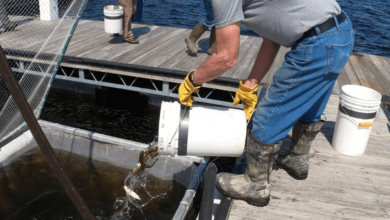New York’s Scows: Workhorse Watercraft


 The wooden a freight-carrying scow was the most ubiquitous vessel in the waters of the New York, and played a crucial role in various industries. The word scow is derived from the Dutch word for the same type of vessel, schouw, which did not enter use in English until the late 1700s.
The wooden a freight-carrying scow was the most ubiquitous vessel in the waters of the New York, and played a crucial role in various industries. The word scow is derived from the Dutch word for the same type of vessel, schouw, which did not enter use in English until the late 1700s.
Typically towed (although some were rigged as sailing scows) it was generally decked, with a flat bottom hull and vertical sides, and its ends angled upward as a common barge (though typically smaller than a barge).

 A small cabin with its door to the stern was often set on one end to provide living accommodations for the barge captain. To support the weight of the cargo, the hull contained an elaborate system of bulkheads, pillars, trusses, or braces, some designed or adapted for a particular type of cargo.
A small cabin with its door to the stern was often set on one end to provide living accommodations for the barge captain. To support the weight of the cargo, the hull contained an elaborate system of bulkheads, pillars, trusses, or braces, some designed or adapted for a particular type of cargo.
Flat, flatboat, coal float, coal barge, chalan (Spanish) and chaland (French) are all historical terms for the type of watercraft employed in inland waters and harbors, including the Bay of New York, and on inland lakes and rivers.
The wooden scow hull in many sizes was adapted for numerous uses. The basic open-deck scow was generally used for non-bulk, non-perishable commodities requiring little or no protection (i.e., brick, stone), the main open deck providing storage.
Based on cargo type, the scow might feature bulkheads forward and aft to avoid cargo spillage. Other scow barges employed to carry perishable products were covered with protective structures. Many hulls were also employed as various types of floating work boats, such as crane barges or derrick lighters.
Scow hull shapes were present in New York waters as early as 1717. And while the evolution of the scow barge is little understood, by the late nineteenth century there was very little design variation in the hull shape.

 From a study of ferries, flats, and barges of the South Carolina lowlands, we do know that the basic vessel form, a rectangular body and raked ends, was present throughout the eastern seaboard by the early 1800s, and it may have been introduced earlier.
From a study of ferries, flats, and barges of the South Carolina lowlands, we do know that the basic vessel form, a rectangular body and raked ends, was present throughout the eastern seaboard by the early 1800s, and it may have been introduced earlier.
Thought to be a vessel reflecting the ethnic origins of its colonists, like its New York area counterpart, the scow type vessel found in South Carolina also appears to have become uniform in design by the mid-to late 1800s.
Further clouding the question of origin and vessel evolution, the early use of the scow was not confined to the coast; it was also a vessel type employed extensively on inland rivers.
Flatboats employed to carry coal down the Ohio River from Pittsburgh area mines as early as 1829 became known as coal boats. These early flatboats had scow characteristics and, by the mid-nineteenth century, varied in length from 160 to 175 feet, and were 24 feet wide and 8 feet deep.
The 1950s were the last decade in which wooden barges and scows were built in any numbers.
Open-Deck Scow
As a vessel type, the wooden-hulled, open-deck scow or flat scow is not well documented. We do know from plans that the deck scow had three or more longitudinal bulkheads, effectively dividing the hull into evenly spaced sections; access to the holds was provided by small manholes, most likely as access for pumping and repair.
However, scows were built with both bulkhead and stanchion type internal construction. A small cabin with its door to the stern was often set on one end to provide living accommodations for the barge captain. The open-deck scow was employed to transfer all manner of nonperishable goods.
Hudson River Rock Scow
These vessels were named for their specific cargo in the late nineteenth century, when quarries along the lower Hudson River produced large quantities of crushed stone and sand for construction use.
Employed to ship other cargoes as well, companies delivered the building material on scows with the same hull configuration as the deck scow (e.g., triple bulkheads), but the rock scow included the addition of timber bulkheads for the retention of cargo, one located on deck at either end.

 This “bulkhead” scow type was an adaptation of the deck scow and the added high deck-end bulkheads were its distinctive feature. The bulkheads situated at the bow and forward of the deckhouse at the stern measured from 2 to 10 feet high in the center but angled downward 45 degrees at either side.
This “bulkhead” scow type was an adaptation of the deck scow and the added high deck-end bulkheads were its distinctive feature. The bulkheads situated at the bow and forward of the deckhouse at the stern measured from 2 to 10 feet high in the center but angled downward 45 degrees at either side.
Vertical timbers supported the bulkheads, horizontally planked and smooth on the side facing the cargo. Companies still transport crushed stone on the Hudson River. The scows are generally of the same configuration as earlier scows, but made of steel.
This essay is excerpted with minor editing for clarification from Target Investigations in Connection with the New York and New Jersey harbor Navigation Project, May 2004, prepared for the U.S. Army Corps of Engineers, New York District, by Andrew D.W. Lydecker and Stephen R. James, Jr. of Panamerican Consultants, Inc.
Illustrations, from above: a Great Lakes sailing scow; the plan for a 1921 garbage scow (NYC Department of Street Cleaning); a sailing scow (bottom right) from William Burgis (1722-1736), “The South Prospect of the City of New York, in North America, 1761”; and the wreck of a scow which was located at Niagara Falls from 1918 until 2022 when it broke up.
Source link




